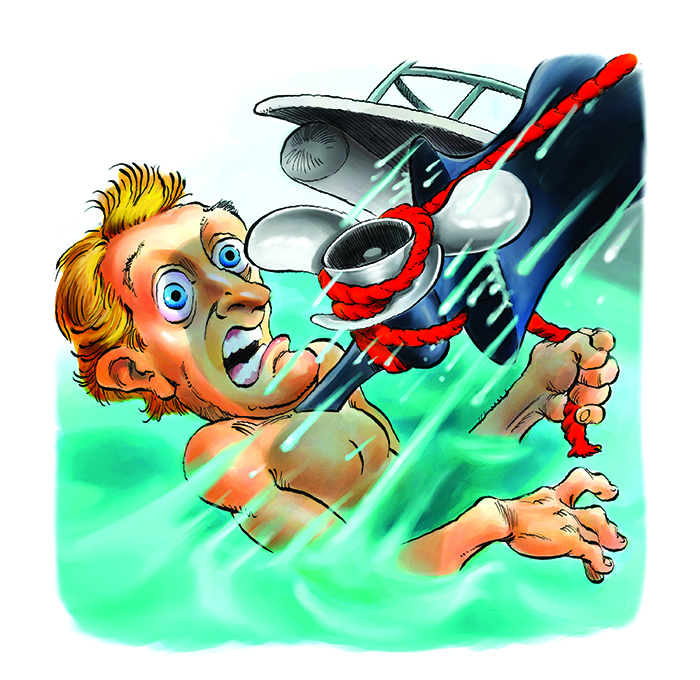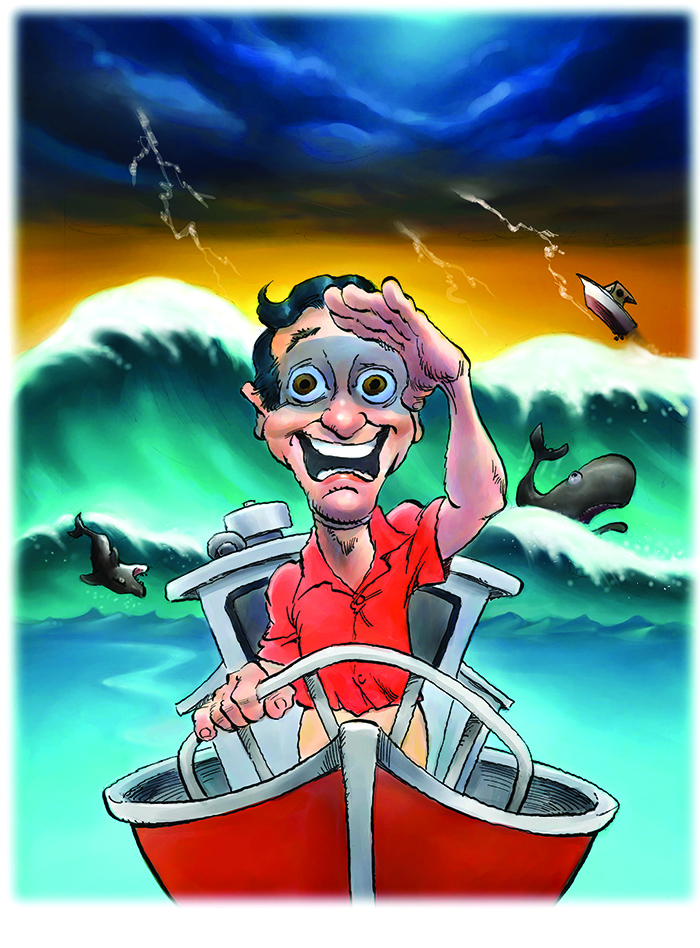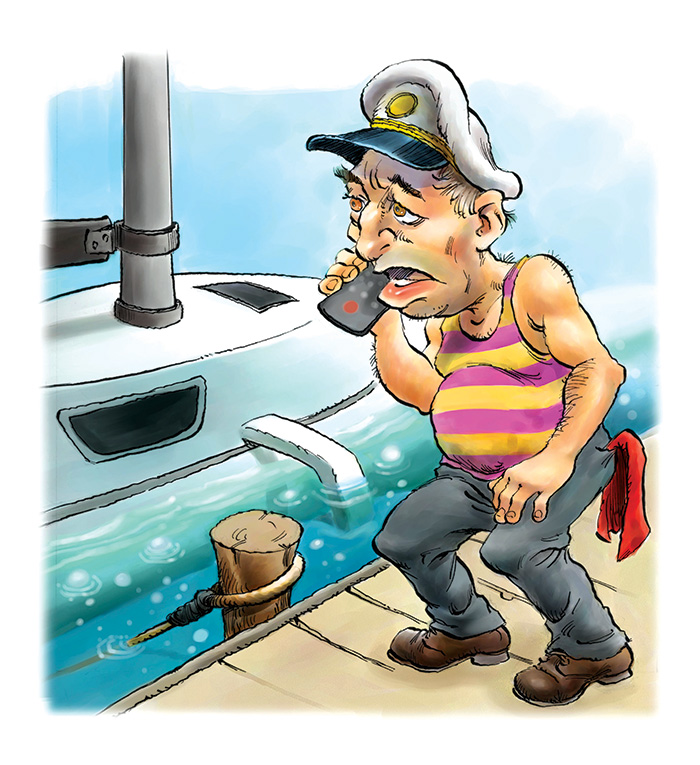Advertisement
Shifting like crazy?
What was planned as a three-day excursion to a marina in Rock Hall, Maryland, turned into a misadventure. We arrived in 19 mph winds with gusts approaching 30 knots and began our approach to our assigned slip. Turning our 48-foot, 1962 vintage motorsailer in the wind is usually a challenge but, on this day, it was really testing our skills. Suddenly, neither forward nor reverse gear would work.
Shifting quickly between forward, neutral, and reverse to rotate the boat had led to the failure of a shaft protector – that polymer spacer set between the transmission and the shaft coupler to prevent damage to the drive train if the propeller is struck. The one installed when we acquired the boat was cracked, so I replaced it with a new one, which my quick shifting had now torn apart.
At first, I thought it was a linkage problem, ran down to the engine, but didn’t see an issue with the linkage. I then ran to the saloon helm and found the same problem there. It took a second trip to the engine to finally realize the shaft coupler had separated from the transmission, leaving us with only one alternative – dropping anchor as we rapidly drifted through Rock Hall Harbor. Luckily our anchor held with very little scope, but that left us in the harbor channel right in front of a busy restaurant. The marine police came to discuss my poor choice of anchorage, and we heard a chorus of unpleasant things from passing boaters. We also provided quite an entertaining spectacle of chaos to the folks at the restaurant and in the small harbor.
Fortunately, we had BoatU.S Unlimited Towing. A pleasant conversation with the BoatU.S. dispatcher hatched a plan to tow us directly home. I called our marina to apprise them of our predicament. With all good intentions, the marina sent out someone in a small Boston Whaler with a 15-hp kicker on the back. After realizing that our boat grosses 23 tons, his jaw dropped, and he went home for the evening. TowBoatU.S. arrived. It was too rough to be towed home, so the captain put us into our assigned slip.
We had a good weekend with our group, although our off-boat plans were put aside as I spent all my time trying to pull, pry, and curse the shaft forward in hopes of mating shaft to transmission. It wouldn’t budge. TowBoatU.S. returned Sunday to safely deliver us back to our home port in light winds. There, we had the boat hauled, the shaft mated to the transmission, and realigned. As the prop was well protected, the spacer was deemed unnecessary and removed. What a weekend! - Bruce Govan, Pennsylvania

Illustration by Steve Haefele
My Inner MacGyver
A few years ago, my family (my wife, two kids, and me) invited another family (parents and one kid) aboard our Coach 21F pontoon boat with a Honda 115 outboard to see the U.S. Navy Blue Angels flight demonstration in Biloxi, Mississippi. On the way there in the morning, the wind was at our backs coming out of the west at about 10 mph, and seas were running with us. All in all, it was a nice trip over and a great air show. We filled up our gas tanks at a marina, then headed home.
The wind had been going all day, and by 4 p.m. we were pounding against wind and waves. Taking 2- to 3-foot waves every 5 to 6 seconds, water was coming over the bow and it was beating us to death. I dropped off everyone with our gear at Gulfport Marina so they could Uber back to the camp, leaving me and the other dad on the boat. At that point, it was riding MUCH better. So good, in fact, that I threw it in neutral once we cleared the marina pier and grabbed a drink and snack.
When I returned to the helm, the motor wouldn’t go into gear and the wheel wouldn’t turn to starboard. After trying a few things without luck, I tilted the motor up and found that the end of our stern line had come undone and was caught in the prop. I’d been using it to hold our second anchor during the show, and one end was still tied to our cleat. I looked for the tools that are usually in the boat – no knife, no tools, nothing!
I donned a life jacket and jumped in the water to try to unwind the line by hand. No good. It was brand-new line – and TIGHT. After a few minutes of wrestling with it, I noticed we were drifting toward the rock jetty. I instructed my friend to drop the anchor off the bow. He did and the anchor held. Now we weren’t drifting, but the boat turned perpendicular to the waves instead of parallel! Instead of a gentle side-to-side rolling of the boat so I could easily work on the fouled prop, the razor-sharp prop was going 4 feet up in the air, then crashing down and going 2 feet under. I could barely work on it, and I was sure it was going to come down on my head. I hollered to my friend, “Hey, if this thing hits me, it’s gonna knock me out. Be ready to jump in and get me.”
He cups his hands to be heard and yells back, “I probably should have told you before … I can’t swim.”
OK, now I’m worried. I swam back to the ladder and dragged myself out of the water. I was looking around for something – ANYTHING – to cut the line. I opened the ice chest to grab a drink and saw the bottles of Corona beer. LIGHTBULB! I smashed a bottle on one of the pontoons, cut the rope with a shard, got it untangled, and we finally made our way home. Needless to say, our prelaunch checklist now includes checking for tools and a knife! - Matthew Patterson, Louisiana

Illustration by Steve Haefele
It looks fine out there
We were headed home to Southwest Florida from an extended cruise up the East Coast and arrived at Marathon earlier than expected. It was 1 p.m., skies were clear, winds were light. We never bothered to check the forecast before carrying on to Marco Island aboard our Nordic Tug 37 – mistake number one. Halfway there, we watched a dark thunderstorm build over Miami, slowly drifting west.
As we rounded Cape Romano off the southwestern tip of the island, the storm had grown into a black wall drifting toward our position. The bay waters turned white with waves and spray. At 7:30, the sunlight surrendered to the darkness of the storm, and we found ourselves in 8-foot waves and 60-knot winds. The sky repeatedly lit up with “brain” lightning that covered the entire overhead sky. We’d find out too late that this is the classic pattern of a frontal passage in that area, or a thunderstorm born in the air between sea and land. Either can be violent.
I slowed the boat to keep from surfing the waves too fast, as we were being thrown back and forth like a bathtub toy. All three bilge compartment pump indicator lights were randomly lighting up. We were taking on water. After two hours of fighting the storm, praying we wouldn’t wrap a crab trap, we finally emerged from the worst of it at 10 p.m., arriving into port at Marco Island at 10:30 p.m. I’ve never been so tired in my life. Moral of the story: Never leave a safe harbor without checking the forecast, and avoid unfamiliar night landfalls at all costs. We should have enjoyed Marathon for another day. - David Bell, Florida

Illustration by Steve Haefele
The saga of piling No. 10
On a darkening Friday afternoon in late May, we launched our British-built Corsair sloop at a local shipyard for a short 4-mile trip to our mooring. Chesapeake Bay was whipping up a squall and we should’ve known better than to attempt the move. But the yard wasn’t open on Saturday, and we were scheduled to leave on a camping trip the next day. My teenage son and I cautiously motored out of the river and into the Bay, headed for the Chesapeake Bay Bridge. Soon the sky darkened even more and rain started pelting down.
The chart showed a point on the bridge with the vertical clearance we needed to get under, and I said to my son, “Watch for piling number 10.” We headed for it, and halfway under the bridge, we were hit with a huge swell – and the sound of crashing wood as the top of the mast connected with the bottom of the roadbed. Stunned, we motored out the other side and continued the rest of the way to the marina. With the weather really declining, we tied up at the dock instead of on the mooring, left a note on the marina office door asking that they tow it out to the mooring the next day, then headed home, exhausted from the drama.
But wait. There’s more! About 7 a.m. on Saturday, someone from the marina called saying they couldn’t tow the boat out because … it had half sunk at the dock! They’d put a pump aboard, but I needed to come up and get it out fast. It was a deep-keel boat, and the trailer was set up for a lift, not a ramp retrieval, so I had to modify the trailer and figure out how to extend it deep enough to get it under the boat at the ramp (long rope).
When we got it home, we found that the mast had smashed the mast step and split the wood keelson. It took all that summer and the next winter to repair the keelson and two fractured boat ribs. We successfully launched the following spring and have enjoyed several summers sailing her since.
When we reviewed the cause of our “accident,” we discovered that we’d both misread the chart’s vertical clearance bridge data and tried to go through the wrong opening with insufficient clearance. Expensive lesson. Now we always double-check the chart AND our plan carefully. - Michael D. Neben, California
Send us your real-life boating stories!
We’ve all been there, when everything starts to go haywire while we’re underway, docking, anchoring, or whatever. Tell us your own scary or humorous tale for possible publication, and send to Magazine@BoatUS.com with “This Boating Life” in the subject line. Include the location it took place and who was onboard, along with some lessons learned, any photos, and contact information. We all learn from each other!

